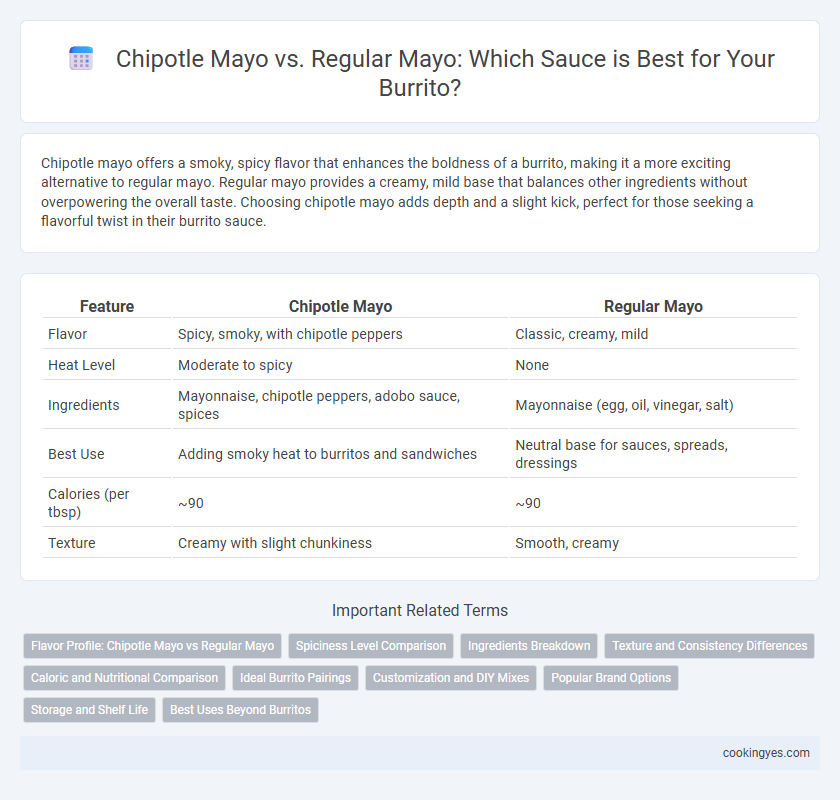Chipotle mayo offers a smoky, spicy flavor that enhances the boldness of a burrito, making it a more exciting alternative to regular mayo. Regular mayo provides a creamy, mild base that balances other ingredients without overpowering the overall taste. Choosing chipotle mayo adds depth and a slight kick, perfect for those seeking a flavorful twist in their burrito sauce.
Table of Comparison
| Feature | Chipotle Mayo | Regular Mayo |
|---|---|---|
| Flavor | Spicy, smoky, with chipotle peppers | Classic, creamy, mild |
| Heat Level | Moderate to spicy | None |
| Ingredients | Mayonnaise, chipotle peppers, adobo sauce, spices | Mayonnaise (egg, oil, vinegar, salt) |
| Best Use | Adding smoky heat to burritos and sandwiches | Neutral base for sauces, spreads, dressings |
| Calories (per tbsp) | ~90 | ~90 |
| Texture | Creamy with slight chunkiness | Smooth, creamy |
Flavor Profile: Chipotle Mayo vs Regular Mayo
Chipotle mayo offers a smoky, spicy flavor with a hint of heat derived from chipotle peppers, creating a bold and zesty taste ideal for enhancing burritos. Regular mayo provides a creamy, tangy, and mild flavor that serves as a versatile base without overpowering other ingredients. The choice between chipotle mayo and regular mayo depends on the desired flavor intensity and spice level to complement the burrito filling.
Spiciness Level Comparison
Chipotle mayo offers a distinctive smoky heat with a moderate spiciness level, making it ideal for those seeking a flavorful kick in their burrito sauce. Regular mayo has a creamy, mild flavor with no spiciness, providing a neutral base that balances bold ingredients without overwhelming heat. Choosing chipotle mayo enhances the burrito's overall taste profile with a subtle but noticeable spicy warmth compared to the smooth, bland nature of regular mayo.
Ingredients Breakdown
Chipotle mayo combines traditional mayonnaise with chipotle peppers, adobo sauce, and spices, delivering a smoky, spicy flavor profile rich in capsaicin antioxidants. Regular mayo primarily consists of oil, egg yolks, vinegar or lemon juice, and a small amount of sugar, providing a creamy texture but a milder taste without added heat or smokiness. The inclusion of chipotle in chipotle mayo increases its flavor complexity and can contribute to slightly higher sodium content compared to conventional mayonnaise.
Texture and Consistency Differences
Chipotle mayo offers a creamier texture with a slightly thicker consistency compared to regular mayo, enhancing the burrito's moisture without overwhelming other ingredients. The smoky, spicy chipotle blend also adds a smooth, velvety layer that contrasts with regular mayo's bland and lighter mouthfeel. This richer consistency allows chipotle mayo to coat fillings more evenly, improving overall flavor distribution in each bite.
Caloric and Nutritional Comparison
Chipotle mayo contains approximately 90 calories per tablespoon, which is slightly higher than regular mayo's 70-80 calories per tablespoon due to added spices and oils. Nutritionally, chipotle mayo often includes capsaicin from chili peppers, providing antioxidants and metabolism-boosting properties that regular mayo lacks. Both sauces are high in fats, but chipotle mayo offers a unique flavor profile with potential health benefits from its spicy ingredients.
Ideal Burrito Pairings
Chipotle mayo offers a smoky, spicy flavor that complements the bold, savory ingredients commonly found in burritos, such as grilled meats and black beans, enhancing the overall taste experience. Regular mayo provides a creamy, mild base that balances the spice from salsa and jalapenos without overpowering other flavors. Choosing chipotle mayo elevates burritos with jalapeno-lime rice and roasted veggies, while regular mayo pairs well with chicken, lettuce, and cheese for a classic, smooth finish.
Customization and DIY Mixes
Chipotle mayo offers a smoky, spicy flavor ideal for customizing burrito sauces, allowing users to control heat levels and ingredient balance. Regular mayo serves as a versatile base for DIY mixes, enabling addition of fresh herbs, spices, and citrus to tailor the taste. Both options cater to diverse preferences, enhancing the burrito experience through personalized sauce creation.
Popular Brand Options
Chipotle mayo offers a smoky, spicy twist compared to regular mayo, making it a popular choice for burrito sauces that add depth and heat. Leading brands like McCormick and Hellmann's provide chipotle mayo variants that blend chipotle peppers with creamy mayonnaise, enhancing flavor profiles. Regular mayo brands such as Kraft and Best Foods remain widely used for their smooth, mild taste that balances strong burrito ingredients.
Storage and Shelf Life
Chipotle mayo typically contains preservatives and spices that may extend its shelf life compared to regular mayo, which usually has a shorter refrigerated storage duration of about one to two months after opening. Both sauces should be stored in a cool, dark place and refrigerated promptly after opening to prevent bacterial growth and spoilage. Proper sealing and maintaining consistent cold temperatures are crucial to maximizing the storage longevity of chipotle mayo and regular mayo sauces.
Best Uses Beyond Burritos
Chipotle mayo, infused with smoky chipotle peppers, offers a spicy, rich flavor ideal for grilled meats, roasted vegetables, and seafood tacos, enhancing dishes that benefit from a smoky heat. Regular mayo provides a creamy, neutral base perfect for dressings, sandwiches, and salads where subtlety is key. Choosing chipotle mayo elevates bold, flavorful meals, while regular mayo complements delicate flavors without overpowering them.
Chipotle mayo vs regular mayo for sauce Infographic

 cookingyes.com
cookingyes.com